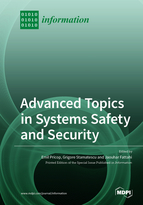Advanced Topics in Systems Safety and Security
A special issue of Information (ISSN 2078-2489). This special issue belongs to the section "Information and Communications Technology".
Deadline for manuscript submissions: closed (30 September 2020) | Viewed by 32434
Special Issue Editors
Interests: cyber security; industrial control system security; sensor networks; system resilience; system safety; smart technologies
Special Issues, Collections and Topics in MDPI journals
Interests: networked-embedded sensing; information processing; control engineering; building automation; smart city; data analytics; computational intelligence; industry and energy applications
Special Issues, Collections and Topics in MDPI journals
Interests: cryptographic protocols; anomaly and intrusion detection; machine learning; deep learning; cyber security; pen testing
Special Issues, Collections and Topics in MDPI journals
Special Issue Information
Dear Colleagues,
This Special Issue will present high-quality papers on systems safety and security. It will be focused especially on extended versions of selected papers presented at the International Workshop on Systems Safety and Security—IWSSS, but other valuable and relevant contributions in this field could be submitted.
The International Workshop on Systems Safety and Security was initiated in 2013 by an enthusiastic researchers’ team. IWSSS 2019 is the 7th edition of the workshop, which has proven to be a prestigious scientific event.
The previous editions of our workshop brought together renowned professors and researchers, practitioners, and implementers from industry, young scientists and specialists from all over the world, making IWSSS a real bridge between academia and industry.
We warmly invite researchers to submit their contributions to this Special Issue. Potential topics include but are not limited to:
- systems security and safety;
- industrial control systems resilience;
- formal methods for security;
- data security and privacy in critical systems;
- physical and logical access control;
- biometric identification of persons;
- malware detection, modeling, and analysis methods;
- security assessment, pen-testing, vulnerability evaluation;
- wireless sensor networks security;
- artificial intelligence used in the field of safety and security;
- industrial control systems security;
- assets tracking, monitoring, and surveillance solutions;
- advanced encryption techniques.
Authors of invited papers should be aware that the final submitted manuscript must provide a minimum of 50% new content.
Dr. Emil Pricop
Dr. Grigore Stamatescu
Dr. Jaouhar Fattahi
Guest Editors
Manuscript Submission Information
Manuscripts should be submitted online at www.mdpi.com by registering and logging in to this website. Once you are registered, click here to go to the submission form. Manuscripts can be submitted until the deadline. All submissions that pass pre-check are peer-reviewed. Accepted papers will be published continuously in the journal (as soon as accepted) and will be listed together on the special issue website. Research articles, review articles as well as short communications are invited. For planned papers, a title and short abstract (about 100 words) can be sent to the Editorial Office for announcement on this website.
Submitted manuscripts should not have been published previously, nor be under consideration for publication elsewhere (except conference proceedings papers). All manuscripts are thoroughly refereed through a single-blind peer-review process. A guide for authors and other relevant information for submission of manuscripts is available on the Instructions for Authors page. Information is an international peer-reviewed open access monthly journal published by MDPI.
Please visit the Instructions for Authors page before submitting a manuscript. The Article Processing Charge (APC) for publication in this open access journal is 1600 CHF (Swiss Francs). Submitted papers should be well formatted and use good English. Authors may use MDPI's English editing service prior to publication or during author revisions.
Keywords
- Systems security
- Systems safety
- Industrial controls systems resilience
- Cybersecurity
- Information security








